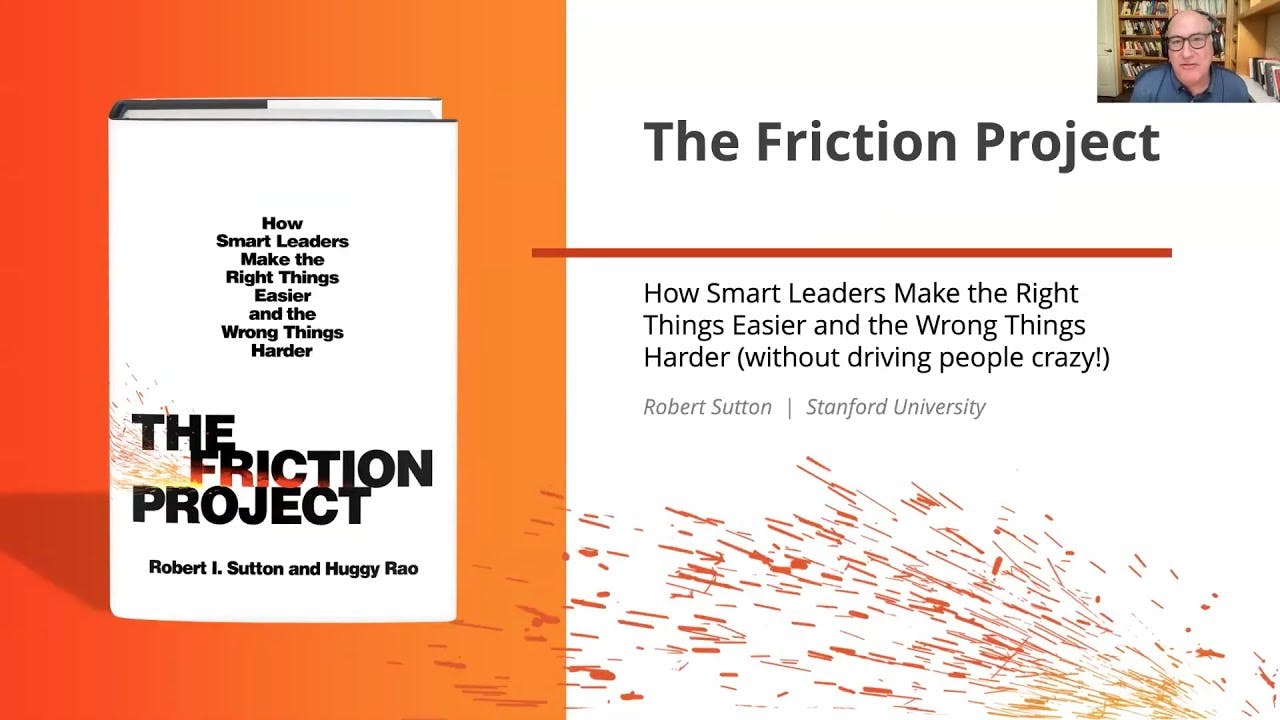“How to Become a Friction Fixer,” with Professor Bob Sutton and Professor Huggy Rao
()

The Friction Project
- The book "The Friction Project" discusses the challenges organizations face in scaling up and the obstacles that hinder individual initiative.
- The authors, Bob Sutton and Huggy Rao, present examples of excessive friction, such as lengthy bureaucratic processes and information overload, which can lead to time poverty and hinder productivity.
- Despite the challenges, the book highlights positive examples of companies that have successfully reduced bad friction and implemented good friction to promote curiosity, generosity, and initiative among their employees.
- The authors emphasize the importance of regularly removing obstacles and inefficiencies (mowing the lawn) to maintain a healthy work environment.
Subtraction Mindset
- The concept of "subtraction mindset" involves identifying and eliminating unnecessary elements that create friction and complexity in various aspects of work and life.
- Examples of subtraction targets include killing Slack channels, reducing the number of back-to-back meetings, eliminating unnecessary standing meetings, and implementing a meeting budget.
- A successful example of subtraction in a large bureaucracy is the simplification of a 42-page form in the Michigan Department of Motor Vehicles, resulting in fewer visits to field offices and increased efficiency.
- AstraZeneca, a pharmaceutical company, launched a subtraction movement led by Pushkala Subramaniam, which saved the company 2 million hours and allowed them to serve 4 million more customers and run 400 early-phase trials.
- Measuring the impact of subtraction efforts should focus on the number of hours or days saved, as this represents the gift of time given back to employees.
- Subtraction mindset becomes a movement when it is embraced throughout an organization, leading to positive outcomes such as increased efficiency, improved customer service, and reduced employee burnout.
Jargon Monoxide
- The video discusses the concept of "jargon monoxide," which refers to empty and misleading communication that serves the speaker's purposes rather than conveying meaningful information.
- Examples of jargon monoxide include Deepak Chopra's use of complex language and the meaningless phrase "humaning."
- Solutions to eliminate jargon include embracing the role of "Editor-in-Chief" and forcing oneself to use clear and concise language.
- Specialized technical jargon can be useful within a specific field but can create confusion and disengagement when used across boundaries.
- AI language models (LLMs) can be effective in simplifying complex language, as demonstrated by a study where a surgical consent form was successfully revised from a 12th-grade reading level to a 7th-grade level using ChatGPT.
- Jargon can devolve over time into a random scatter of ideas, as seen in the example of design thinking and the 40 agile methods defined by Craig Smith.
- Jargon creates confusion and disengagement, hindering effective communication and message scaling.
Friction Forensics
- The concept of "friction forensics" is introduced, emphasizing that organizational friction can be good when it prevents unlawful or dangerous actions.
- Friction can also be beneficial when solving complex problems, as individuals with higher IQs take more time to understand all the pieces before coming up with a solution.
- Rushing creative work can hinder the process, as creativity is an inefficient process that requires time and patience.
- The best leaders are "Trustees of Others Times" and "Friction Fixers" who make the right things easier and the wrong things harder.
- Building strong emotional bonds and understanding each other's roles within a team leads to greater effectiveness in accomplishing difficult tasks.
- Clara Shai suggests that preparing teams for the messy, confusing, and frustrating nature of friction-fixing can help them navigate the process more effectively.
Time Poverty
- Time poverty is a significant problem for employees, leading to exhaustion and a lack of fulfillment in their personal lives.
- The design of organizations and work itself needs to be addressed to solve the problem of time poverty, rather than relying on psychological solutions like meditation apps.
- The goal is to make work a better experience, not a grind, and the audience's help is appreciated in this effort.